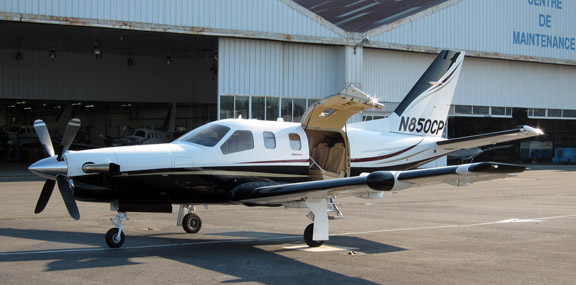
This article describes a flight done in the Socata TBM850, by a TB20 owner who has 1200hrs total time (mostly on the Socata TB20) but no turboprop experience.
The Aircraft
The TBM700 was introduced in 1991. It is a single engine pressurised turboprop with 700 SHP (shaft horsepower). The airframe is constructed almost entirely of aluminium, with extensive use of press tooling and CNC machining. Seating configuration is 2 in the front and 4 in the rear in a "club" arrangement
Most of the TBM700s had standard "1990s high-end GA" avionics, comprising of the Honeywell EFIS-40, the KFC-325 autopilot, and various separate instruments.
The TBM850 was introduced in 2007 and replaced the TBM700 in production. It is structurally identical to the TBM700, but has a larger engine and an option to disable the torque limiter during cruise, yielding 850 SHP. The turbine engine is capable of about 1800 SHP but this power cannot be utilised because of two factors: the gearbox is the main limiter on torque, and the ITT is the main limiter on power.
All but the earliest TBM850s were fitted with the Garmin G1000 avionics package, which includes the GFC700 autopilot
Above image from Socata
The G1000 can also be retrofitted to TBM700s, for around $400k.
Today (2010) one can buy a good mid-1990s TBM700 for around $1.2M-1.5M according to engine time and other details. This would have the EFIS-40 avionics which are now poorly supported by Honeywell but the components are widely available on the U.S. overhauled avionics market. Here is the panel from a reasonably late-model TBM700
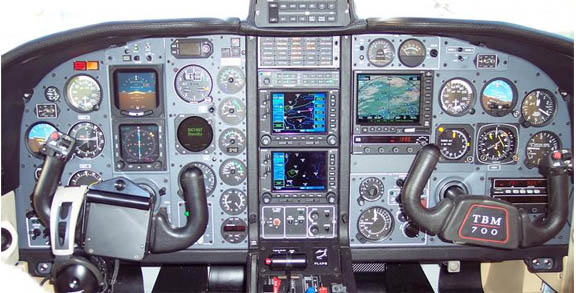
Today's new TBM850 price, in a typical configuration with some options, is around $3.2M.
Performance
Being a single engine aircraft, the maximum stall speed of the TBM was originally limited to 60kt. Later TBM700s had this increased to 65kt, to improve the payload. This was done by improving the crashworthiness; specifically by fitting seats capable of withstanding 20g. This concession was originally certified by the FAA and later by EASA. Nevertheless, a Vs of 65kt leads to a good short field capability.
There is no official Vne on the TBM; instead there is a Vmo (maximum operating) of 266kt IAS. Va is 158kt IAS at MTOW.
The gear and flaps can be extended to the initial (takeoff) position at 178kt IAS. Landing flap can be extended at 122kt IAS.
MTOW is 3354kg. Standard empty weight is 2060kg, yielding a payload of 1294kg. Total fuel (including 24 litres unusable) is 1140 litres, so assuming 0.775kg/litre for avtur at +15°C, the payload with full fuel is about 400kg.
To any "normal" piston aircraft pilot, the climb performance is impressive: 2000fpm initially at MTOW, increasing to 2800fpm at lighter weights.
Max cruise speed is 315kt (FL270). Normal cruise is 312kt (FL250). Long range cruise is 252kt at FL310 when the fuel flow is 41.3 USG/hr (all at ISA, MTOW). The zero-fuel range appears to be in excess of 1700nm which means that flights up to about 1400nm can be done - depending on the availability of alternates which in Europe tends to be the biggest issue. There is a complex matrix of operating altitude, weight, temperature, etc. In realistic conditions the range with legal IFR reserves is 1100nm at maximum cruise speed and 1200nm at recommended cruise speed. For comparison, the zero-fuel range of the TB20 is over 1300nm which is itself outstanding among piston aircraft.
The 50ft-obstacle landing distance is 2430ft (760m) at sea level, ISA, MTOW. The corresponding takeoff 50 ft-obstacle distance is 865m.
The aircraft is evidently solidly engineered because one can do an emergency descent from say FL300 to FL120 in about 2 minutes, with the IAS being held just below the 266kt Vmo and with the VS reaching -8000fpm

The pitch attitude can be nearly 30 degrees down in this situation and the TAS can briefly reach nearly 400kt. The high level cruise IAS is about 200kt which with the Vmo of 266kt gives a big margin for descending and other situations where high speeds may be involved. No TBM aircraft has ever suffered an in-flight structural failure, which is a very rare achievement.
This may be stating the obvious but the TBM is much less affected by atmospheric conditions than the TB20, whose ceiling is significantly temperature-dependent. At ISA conditions, which means a temperature of -25°C at FL200, a TB20 can just about climb to FL200 after 30+ minutes, doing 95kt IAS (130kt TAS) at "best power" (100F ROP) fuel flow of about 10USG/hr
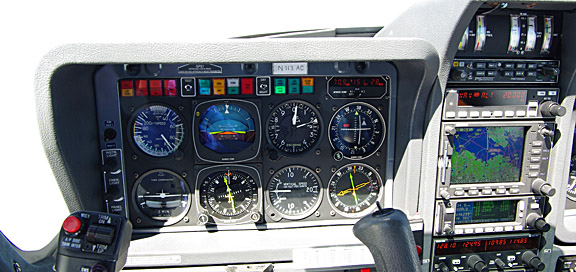
But in say ISA+20 conditions (FL200 temperature being -5°C) the TB20 ceiling will be only about FL170. This has a significant impact on the ability to outclimb weather, whereas a TBM goes to FL280 - above 99% of non-frontal weather - like a rocket, in about 18 minutes, shown here in cruise at 157kt IAS / 257kt TAS (in ISA+10 conditions) which corresponds to just above the long range cruise power setting at about 43 USG/hr
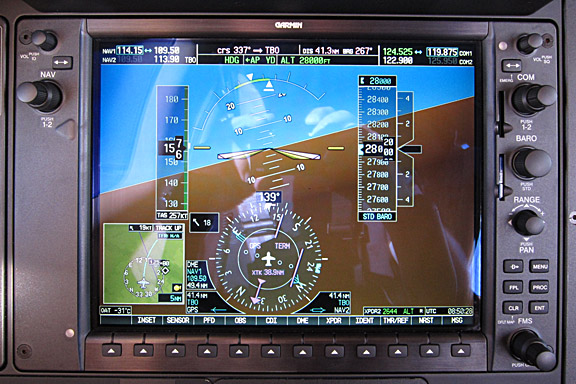
and can climb to FL310 at MTOW and ISA+20 which takes it above all but the most convective conditions.

The above cloud tops were around FL170 which would be more work in the TB20, pictured below from a flight later on the same day
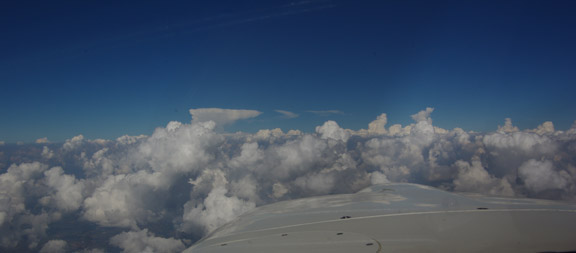
At higher fuel flows, 300kt+ TAS is readily reached - 307kt here, in ISA+10 conditions
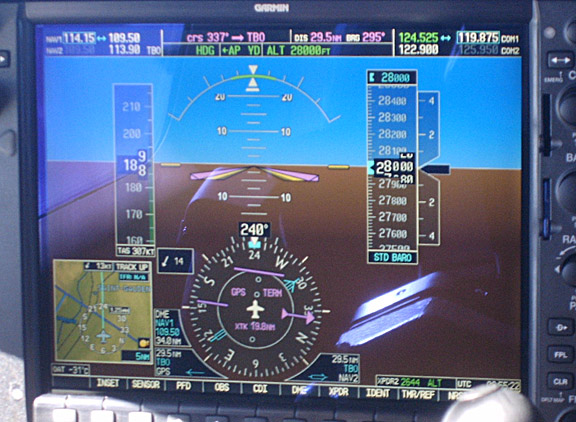
Together with the de-ice equipment and radar, this translates to an improvement in the despatch rate from around 75% for the TB20 to probably around 99% for the TBM.
Operation
Flying the TBM is straightforward. Rotation is at 90kt with an initial pitch of 7.5 degrees, followed by a climb at 130kt at a 10 degree pitch. The approach speed (Vref) is 85kt (MTOW).
The traditional piston engine management issues (leaning, shock cooling, etc) are gone. During flight, the blue propeller pitch lever is always in the fully forward position, and the red fuel control lever is likewise. There are limits, however, which need to be watched, in the form of ITT (inter turbine temperature) whose continuous limit is 840°C, and the torque, which is indicated as a percentage, is limited to 104%. Overall, the engine management is simpler than with a piston engine; especially a turbocharged one, and the contrast is greater in practice because now there is so much more performance to play with. There are no issues with "shock cooling"; a descent can be made with the power rapidly reduced to idle.
The Garmin autopilot is excellent. Unlike the Honeywell KFC units which sometimes need track intercepts to be carefully set up via the HSI, it works just as one would expect an autopilot to behave. For example, in NAV mode, you enter a waypoint (the G1000's keypad makes this easy), press DCT, the course pointer flips to the new waypoint, and the aircraft simply flies there, accurately. The same happens if NAV is selected when the aircraft is pointing somewhere else; the autopilot works it out. There is no need to fly a HDG-mode intercept, with NAV ARM, onto the new track. The vertical behaviour is equally logical but - in the simplest case - you do have to select the vertical speed. And the VS still does need to be set in the appropriate direction; if you are at FL100 and you set FL300 as the desired altitude but you set the VS to minus 500fpm, 20 minutes later (or sooner) you will hit the ground. The lateral and vertical intercepts are precise, and remain so throughout flap and gear movements.
The G1000 system presents the engine and other operational parameters very clearly
and comes with a keypad for rapid waypoint entry - a feature much desired by IFR pilots which is missing on all but the most modern piston aircraft
The above pic shows the three engine controls but the aircraft operation is practically single-lever when airborne. The fuel selector is also servo-driven and changes over automatically at regular intervals.
Pilot Qualifications
US registered aircraft
No Type Rating is required because the TBM is below 12500lb and is not a turbojet. There is a "High Altitude Endorsement" ground course with 1 flight to simulate explosive depressurisation and oxygen mask use, etc.
FAA prerequisites are: PPL, CPL or ATPL. To be PIC of N-reg TBM you need three endorsements, all of which can be issued by any FAA instructor: High Altitude (all aircraft certified above FL250), High Performance (all aircraft with more than 200 HP per engine), and Complex (all aircraft with retractable gear).
EASA registered aircraft
In EASA-land, no Type Rating is required but there is a Class Rating called: "Aerospatiale S.E.T." (the name was later changed to "Aerospatiale TBM").
The Class rating is valid for 2 years and it is mandatory to pass a Class Rating proficiency check to renew the Class Rating every 2 years. This Class Rating can be done by a Class Rating Instructor (CRI); it is not mandatory to do it in a Flight Training Organisation (FTO) but in reality very few CRIs are qualified to do it. After the training, the Check Ride will be done by a Class Rating Examiner (CRE).
JAA prerequisites are: PPL, CPL or ATPL, and an "HPA" (High Performance Airplane") course certificate. The "HPA" course must be done in a Flight Training Organisation (FTO) and, depending on which EU country you do it in, involves a few days in a classroom followed by one written exam. There are two alternatives to the HPA: (1) Any ICAO ATPL; (2) JAR-FCL ATPL exam passes (14 written exams).
After April 2016?
It is not clear what pilot papers will be required under EASA FCL to operate an N-reg TBM850 after April 2016 if the operator is EU based - more information here. The regulation itself is deliberately vague, with no definitions for operator residence, etc. Assuming the operator decides that he is EU based (which is probably true for most owner-pilots based on mainland Europe and mainland UK) an EASA PPL and an EASA medical will be needed. For obvious practical purposes an EASA IR will also be needed. But EASA proposes to accept ICAO Type Ratings, so it is not clear whether it will require an EASA HPA. It's a big mess... and that's before you get onto other aircraft which need a TR in EASA-land and not in FAA-land (e.g. the PA46). Predictably, the strictest interpretation is that HPA will be required for the TBM.
There are various places where one can do an HPA course. One is here which costs of the order of €1000 (Dec 2013).
An alternative to doing an HPA course is to have an ICAO ATPL theoretical knowledge pass, but do not need the actual ATPL or checkride (or any flying). The easiest way to comply with this is to sit the single FAA ATP written exam which can be sat at e.g. Farnborough, UK, and does not need any instructor endorsement; you just turn up and sit it. Unfortunately, you cannot sit the FAA ATP exam unless you already hold an FAA CPL, and the only straightforward way to do an FAA CPL is to go to the USA, with the TSA/VISA process (described here - however the CPL may well be TSA exempt as it was when that article was written). Also, this whole FAA ATP exam pass route is due to become more complicated after 14 July 2014 - see this discussion.
Socata Pilot Training
Socata offer a pilot training package. Socata's initial requirements are: an IR, 500hrs TT as PIC (or P1 if arriving with multi-crew time), a PPL, CPL or an ATPL, and a Class 1 or 2 medical. On EASA registered aircraft, the HPA course completion or theoretical ATPL(A) credit are required.
A typical package is 50hrs of self study, a 4-day ground school, and 4-5 days of flight training normally comprising of 4 flights and a checkride.
An IR is not legally mandatory for either US or EASA registered aircraft, but a TBM does not make any sense without an IR.
In reality, regardless of aircraft registration, the insurance company will require the pilot to have a training certificate and to fly with a safety pilot (an experienced TBM pilot) for 25, 50 or more hours.
Clearly, the TBM requires an intelligent pilot, but no more than the TB20 whose operation involves thinking well ahead, nontrivial engine management, proper vertical navigation, and other concepts not taught at the PPL level.
The Flight
There is no FADEC on the PT6 engine; Pratt & Whitney have thus far declined to develop one, citing various technical reasons. However, engine startup is simple. The starter is run until a specific RPM is reached and then the fuel control is opened. The ITT must be watched; if it is heading towards 850°C, the fuel lever must be closed while running the starter on to cool the engine. If the engine has been recently run, it could still be hot inside and if the ITT is above 150°C initially, the fuel must be delayed until the ITT falls below this level, while running the starter to move the air through.
Taxi is really easy and is easy to do accurately. The top of the panel is however about 20-30mm higher than in the TB20. The propeller pitch is reversible and this is the main means of taxi speed control; one uses thrust reverse instead of the brakes. It is a very positive system, which involves small movements of the throttle lever, near the bottom end of its travel.
There are two generators and both (as well as battery power alone) are tested individually during the preflight check. The de-ice boots are in several sections and are individually tested.
We departed from the factory airfield - Tarbes LFBT - and climbed to FL280 within the Toulouse test area. The climb took about 18 minutes. The rate of climb was +2200fpm at FL170 - impressive, more so in the ISA+15 conditions, and about 20 times greater than the TB20 at FL170... Cabin altitude at FL280 was 7700ft and is automatically controlled.
This was followed by the simulated-depressurisation emergency descent mentioned above, down to FL120 - an amazing maneuver which would have probably wrecked a piston engine, not to mention exceeding the Vne of many other aircraft.
Stalls were done in various configurations. The stall behaviour is well defined and the wings can be kept level not just with the rudder but also with the ailerons which remain effective due to the assistance from the spoilers on top of the wing. A fully developed stall, if maintained but otherwise ignored, produces an exciting result in the form of a rapid nose down attitude, with a left wing drop presumably due to the radar there.
It has been alleged that the TBM does not have sufficient aileron authority to deal with maximum propeller torque at low speeds; this was shown to be untrue. To simulate an ILS go-around recovery, at 70kt in level flight, landing configuration, a sudden application of engine power from 0% to 100% resulted in a rapid acceleration with a barely perceptible and easily controllable left roll of a few degrees. Significant forward yoke pressure was required to prevent a rapid pitch-up (which would potentially result in a secondary stall) and to convert the massive engine thrust into a controlled climb at an increasing speed, but this yoke input is required in the TB20 also; one cannot just push the throttle to the wall and sit there doing nothing... well, in a Cessna 150 one probably can.
The response time to the throttle is good, with an impressive acceleration, but not so good below 20%, when there is a delay of a few seconds.
Like any high performance piston aircraft, the TBM is flown by the numbers. On the ILS, the torque is set to 50% in level flight and up to localiser intercept; this produces 160kt. At glideslope intercept, torque is reduced to 30%. At 1 dot below the GS, the gear and initial flaps are extended. At 1000ft above airfield level, the landing flap is extended and this enables the autopilot (if used) to stabilise in time for the 200ft DH point.
The main power difference between the TBM700 and the TBM850 involves the override of the torque limiter, which can be done in cruise only; the control is on the flap lever, beyond all the flap settings, so it cannot be operated during takeoff. Otherwise, the torque limit (indicated on the G1000) decreases during climb, to help prevent ITT being exceeded in thinner air.
The overall impression is of an aircraft which is very easy to fly. The takeoff is completely familiar but one does climb a lot faster, which is always a good thing... there is no such thing as having too much power when trying to get off the ground. The TB20 has relatively heavy ailerons so in flight the TBM feels familiar, but it does feel a bit bigger. Reasonably steep turns are a piece of cake to do, with the altitude held accurately. The approach speed of 85kt is same as what I use for the TB20; I often start the final at 100kt and following full flap deployment, some trimming, and some speed loss due to wind shear I am down to 85kt on short final, so the TBM did not feel any different. The touchdown is more firm - the suspension travel is a fraction of the TB20's trailing link system - but this appears to result in less bouncing around.
On shutdown, the prop is feathered, followed by a 15 second wait to cool the engine down, then the fuel is shut off.
I was most suprised at how easy the G1000 cockpit was to get used to. I had almost no experience of it, and zero as P1. The integrated presentation of all the information is excellent. This aircraft had the optional Jeppesen package which shows the aircraft on the approach plate
in a manner similar to the FliteDeck PC product which is included with Jeppview 3. The aircraft position depiction also works with airport diagrams so there is now no excuse for getting lost...
As can be seen from the LCD screen reflections, the G1000 does not use the special sunlight-readable LCD technology which is now available in top-end ($3000) industrial/military tablet computers, but the displays remain readable with sunlight in the cockpit.
Operating Costs
Obviously, these will depend heavily on the usage. The aircraft age will also have an effect due to the unscheduled maintenance in later years.
The fuel burn is around 50USG/hr or 190 litres/hr. The cost of the fuel, per mile, is only about 40% higher than on a TB20. However, this is partly due to the avtur-avgas tax differential which is, in theory anyway, now finished in the UK for "private" flights.
Being over 1999kg, there are the European enroute charges, collected on behalf of each country by Eurocontrol, and these come to roughly 50-100 euros/hr depending on weight, the airspace flown in and how fast one is flying. The billing is done according to maximum certified takeoff weight, and the distance flown. On the piston aircraft scene, these charges are traditionally avoided by flying "VFR" but the TBM will return a poor fuel economy at the low levels at which VFR flight is predictably permitted around Europe. Notably, France bans VFR in a large chunk of its airspace, above FL115.
The Annual at Socata's factory is 8k euros (2010), plus of course any corrective work. Unlike with piston aircraft, many European TBM owners go back to the factory for the Annual.
In between the Annuals, there are 100hr checks which are 2k euros (2010), plus corrective work.
The engine needs an overhaul at 3600hrs which costs about $300k (2010). Early TBM700 engines were 3000hrs, and there is an SB which can be applied to the engine to get the 3600hrs interval.
According to owners, it is not unusual for maintenance to cost $60k/year (2010), if flying 250hrs/year.
Depreciation is potentially a big factor but a TBM purchased say 15 years ago was about $1.6M and might sell today for $1.2M so on that basis it is not as large an item as on most piston aircraft.
Interest on capital can be accounted for in many ways, and it can be argued that if a private owner fully accounted for it on everything he buys, he would die extremely rich, with every penny invested in financial instruments, and without ever achieving anything worthwhile in his entire life.
Insurance for a new TBM850 ($3.2M hull value) would be around £20k-£25k (2010) in the UK. This figure is from Haywards Aviation Insurance, for a 1000+hr CPL/IR pilot, 200hrs/year usage. Hangarage does not affect it.
Hangarage varies greatly according to the area. In the south east of the UK one might pay £7k for a TB20 or £15k for a TBM (these are actual figures). In the north of the UK where property values are much lower, these figures can fall to 1/3. There is also less need for hangarage on a pressurised turboprop; most of the engine parts that are exposed to the weather are made of relatively corrosion resistant high temperature alloys, and the sealed cockpit makes it easy to control humidity with a bag of dessicant. As a result many turboprops are simply parked outdoors.
There is the inevitable comparison with light jets... For European usage, the TBM's slightly lower speed is insignificant, but its short field capability is highly significant given Europe's large number of short (500-1000m) runways, and many grass runways.
Negatives
There are no obvious negatives; this is a high quality aircraft with an awesome performance, which is perfect for nonstop long range flights within Europe. It is just a matter of whether one can afford it.
The operating cost is obviously a lot higher than a TB20, though not exceptional compared with other aircraft of similar mission capability, and one is getting a whole lot more for the money. I would estimate the cost per mile to be around 3x to 7x higher than a TB20.
For "large" pilots, getting into the front seats would be no easier than in the TB20 and harder in some ways due to the limited headroom in that area. It is no suprise that the $90k pilot's door is a popular option.
Pilot: FAA CPL/IR 1200hrs TT (2010)
Last edited 6th December 2023.
Any feedback, reports of dead links, corrections or suggestions much appreciated
Contact details